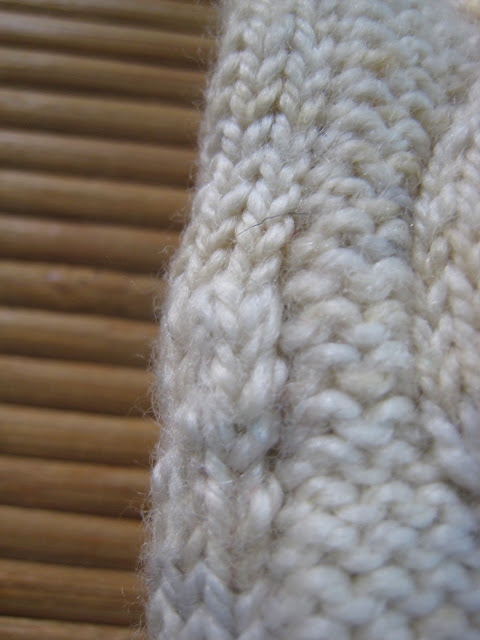Recently I've been trying to focus on the half-worked projects lying around. One of those was a repair — a very difficult repair.
Back in 2011 I reworked the Serpent of Eternity socks in a way that involved double-knitting. And then at some point, I wore them and put them in the wash. There was a weak spot in the yarn at the top of the sock. The movement in the wash broke the yarn. I ended up with a hole in the double-knitting.
I had tried previously to mend this, but failed. Finally, I found a day when I
thought the stars might be aligned. I started by putting pins in the hole to
prevent further raveling. The pink is a cable needle in the interior of the
i-cord edge.
I grafted things together provisionally, but something seemed off. Eventually, I got out green and red sewing thread. I started lower than the hole and duplicate stitched green thread across a row. Then I did the same in the row above, this time with red thread. Then again with green. As I progressed, sometimes I made stitches to replace those lost.
And here's what it looked like on the other side: There was a spot where one of two strands of yarn had been lost — a stitch that was half as thick. That got me thinking about how to make the repair. If I used half a strand to make the repair, would it be too weak? If I used a whole piece of yarn, would it be too thick? I decided to reinforce the area with white silk thread. I ran duplicate stitches and grafting in white silk through the whole area, taking the extra time to make the silk lie to the inside of the work where it wouldn't show. That was the first day. All that duplicate stitch and grafting — in some parts of the sock I had done this three times — took about 5-6 hours.The next day I got up, determined to complete the task. I took out my precious one spare yard of this hand-dyed yarn. I carefully worked duplicate stitch and grafting, removing the green and red threads as I went but leaving the white reinforcement silk in place. That took another 2 to 3 hours.
The completed repair is a little bumpy. But, it is complete. I can wear the socks again. Here is what it looks like on the outside, which is where the hole was.And here is the inside. I was lucky on the inside the left most wale was intact and the next-to-left wale was mostly intact.What have I learned about mending?Thread is your friend! The color-coding was a big help. Also, mending can't be rushed. Take your time. And keep a spare yard or two of yarn from each project, just in case.
I'm glad I had skills to do this. I am guessing there are a handful of people in the United States who could have attempted it?







Comments